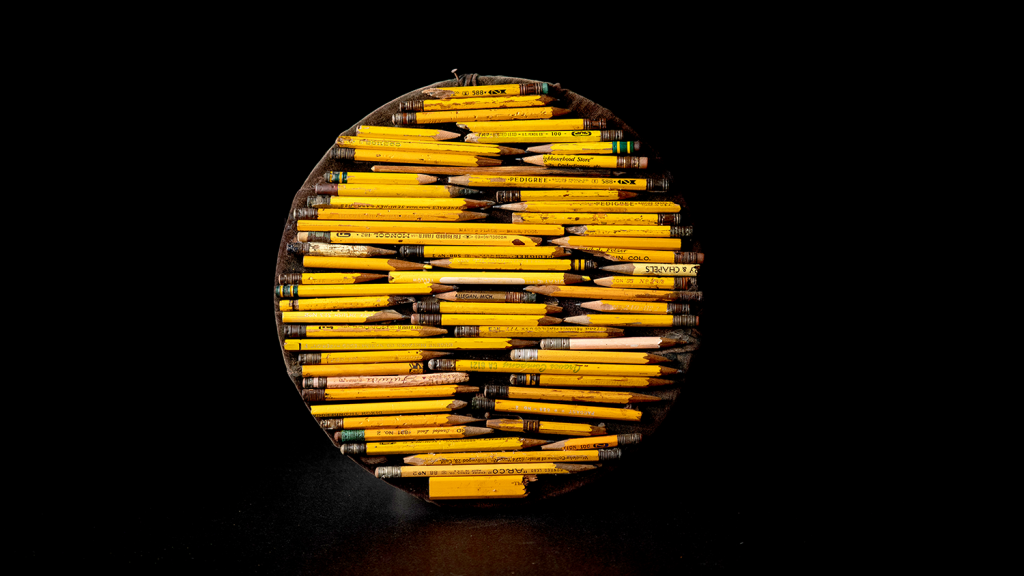At the LA Central Public Library through Jan. 27 is an engrossing (and free!) exhibit called “21 Collections: Every Object Has a Story.”
Dominating the central space is a life-size elephant — now there’s an attention grab! — made entirely of unshelled walnuts.
Along with 550 jars of fruit, 200 pounds of honey, and 450 plants and trees, this was the Golden State’s proud contribution to the Chicago World’s Fair of 1893. The idea was to sell Southern California as a land of prosperity, wealth, and leisure, an effort that might technically be classed as boasting rather than collecting. Still, let’s face it, we are kind of great. So the walnut elephant gets a pass.
Grandma “Tressa” Prisbrey (1896-1988) had a thing for pencils. After amassing upward of 17,000, she decided at the age of 60 to build a shed on her Simi Valley property to house them. Lumber being a bit of a luxury, she started combing the area dumps for discarded glass bottles.
The eventual result was 16 separate houses and innumerable folk art assemblages that have come to be known as “Grandma Prisbrey’s Bottle Village,” and is on the National Register of Historic Places.
The accompanying video of Grandma in her heyday is worth watching, if for no other reason than her hilariously spirited account of being stopped by the cops in an unregistered, uninsured, rattrap of a motor vehicle.
A passerby apparently once asked, “Are you the crazy woman who built this house?” “I guess so,” she replied, “ain’t nobody else here.” On view are some of her pencils, unseen for decades, and arranged in whimsical neo-expressionistic squares, circles, and wheels.
Karen Collins, a Compton elementary school teacher, began building shadow box dioramas after sinking into a depression following the 167-year sentence handed down to her son Eddie on gang-related charges.
Her vignettes — among them Ghana’s medieval Elmina Castle, former Dutch trading outpost and “slave factory”; Madame C.J. Walker (née Sarah Breedlove, 1867-1919), “hair culturist” and the first black woman millionaire; and Martin Luther King Jr., wiping the sweat from his brow and preaching to a packed church, are painstakingly detailed, deeply researched, lovingly crafted, and altogether captivating.
Collins travels the city with her African American Museum of Miniatures hoping to introduce a new generation to this rich history.
Artist Vincent Ramos has created an assemblage entitled “Venice Archive Fragment as Venice Altar Study, 1936-2018.” Vintage real estate brochures, newspaper clippings, magazine ads, family ephemera, posters, photos, and found objects combine to create a kind of visual history shrine to the Venice neighborhood of LA where, pre-gentrification, Ramos’ grandfather lived along one of the canals and made his living as a trashman.
Saskia Wilson-Brown, fascinated by perfumery and scents, is the founding director of the Chinatown-based Institute for Art and Olfaction (IAO). Petrichor — rain on dry dirt — always an especially welcome whiff here in LA, is a recognized fragrance, turns out, in the world of smells. IAO’s version is a combination of Texas cedar, geosmin, and rose oxide.
Los Angeles Unified School District Spanish teacher George B. Smith amassed a collection of bullfighting memorabilia in his Westlake apartment, then in the 1980s donated it to the library. The posters, books, photographs, magazine covers, and flyers comprising the Biblioteca Taurina afford a bird’s-eye view into a unique Southern California subculture.

There’s much, much more: Tom Hanks’ collection of stylish vintage typewriters; Clare Graham’s settee and end table fashioned from soda can pop-tops; Darlene Lace’s “Candy Wrapper Museum” (remember Jujyfruits, Bit-O-Honey, and candy cigarettes?); Morgyn Owens-Celli and his American Museum of Straw Art; bird eggs — Ventura County’s Western Foundation for Vertebrate Zoology has more than a million of them — and nests.
Paper airplanes, most of which were found by collector Harry Smith on the streets of New York City; chunks of road tar from Dr. Victor G. Gordon’s World Famous Asphalt Museum; an intriguing photo genre, collected by Alyse Emdur, which consists of shots taken of prison inmates against painted fantasy backdrops of tropical paradises, seascapes, or snow-capped mountains; Olive Percival, the Miniature Milliner (the hats, not Olive) of the (Pasadena) Arroyo. “It is true,” she observed, “and I do not apologize — that to me domestic duties are ‘fine’ arts.”
Perhaps our attraction to collecting is some atavistic leftover from millions of years ago when humans were still insects, or wasps, or birds. I personally am drawn by wee, and I do mean wee, bowls.
I took a pottery class a few years ago and after eight weeks had produced about 60 misshapen vessels capable of holding, say, one used teabag, three paper clips, or a single beak-full of pollen. My whole being thrilled to see these tiny, nest-like objects, thereby strengthening my conviction that in a past life I flew the earth as an Anna’s Hummingbird.
While you’re at the Central Library, grab a book, visit the café, sit in the courtyard. Look around. Think about starting your own collection: cigarette butts, discarded pieces of gum, fallen olive tree leaves. The sky’s the limit.
Heather King is a blogger, speaker and the author of several books. For more, visit heather-king.com.
SPECIAL OFFER! 44 issues of Angelus for just $9.95! Get the finest in Catholic journalism with first-rate analysis of the events and trends shaping the Church and the world, plus the practical advice from the world’s best spiritual writers on prayer and Catholic living, along with great features about Catholic life in Los Angeles. Subscribe now!

